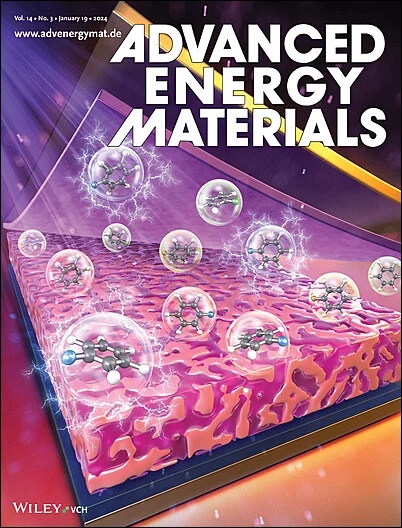Additive Engineering of Sequentially Evaporated FAPbI3 Solar Cells
IF 26
1区 材料科学
Q1 CHEMISTRY, PHYSICAL
引用次数: 0
Abstract
Despite the tremendous progress made in the field of perovskite solar cells, their commercialization remains hindered by several challenges, including scalability, stability, and sustainability. Thermal evaporation is a solvent‐free, scalable, and industrially relevant method, yet despite its many advantages, this method is limited by the lack of additive engineering strategies for controlling the growth of perovskite layers. Here, a novel additive engineering strategy is reported that enables the complete conversion of precursors to a perovskite phase during the two‐step deposition of formamidinium lead triiodide (FAPbI顺序蒸发FAPbI3太阳能电池的增材工程
尽管钙钛矿太阳能电池领域取得了巨大的进步,但其商业化仍然受到一些挑战的阻碍,包括可扩展性、稳定性和可持续性。热蒸发是一种无溶剂、可扩展和工业相关的方法,尽管它有许多优点,但由于缺乏控制钙钛矿层生长的添加剂工程策略,这种方法受到限制。本文报道了一种新的添加剂工程策略,可以在两步沉积三碘化甲醛铅(FAPbI3)的过程中将前驱体完全转化为钙钛矿相。该方法是基于在第一步沉积过程中含钾添加剂(KI和KSCN)与PbI2的共蒸发,然后是碘化甲醛的蒸发。结果表明,不添加添加剂会导致不完全转化,大量未转化的PbI2残留在埋藏界面上。另一方面,添加剂的共蒸发改善了转化过程,在KSCN的情况下,导致了相纯的α - FAPbI3,并改善了微观结构。添加剂设计的p - i - n器件的效率高达18.34%,是无界面钝化蒸发FAPbI3太阳能电池中最高的效率之一。这项工作突出了添加剂工程在控制热蒸发钙钛矿成膜方面的巨大潜力。
本文章由计算机程序翻译,如有差异,请以英文原文为准。
求助全文
约1分钟内获得全文
求助全文
来源期刊

Advanced Energy Materials
CHEMISTRY, PHYSICAL-ENERGY & FUELS
CiteScore
41.90
自引率
4.00%
发文量
889
审稿时长
1.4 months
期刊介绍:
Established in 2011, Advanced Energy Materials is an international, interdisciplinary, English-language journal that focuses on materials used in energy harvesting, conversion, and storage. It is regarded as a top-quality journal alongside Advanced Materials, Advanced Functional Materials, and Small.
With a 2022 Impact Factor of 27.8, Advanced Energy Materials is considered a prime source for the best energy-related research. The journal covers a wide range of topics in energy-related research, including organic and inorganic photovoltaics, batteries and supercapacitors, fuel cells, hydrogen generation and storage, thermoelectrics, water splitting and photocatalysis, solar fuels and thermosolar power, magnetocalorics, and piezoelectronics.
The readership of Advanced Energy Materials includes materials scientists, chemists, physicists, and engineers in both academia and industry. The journal is indexed in various databases and collections, such as Advanced Technologies & Aerospace Database, FIZ Karlsruhe, INSPEC (IET), Science Citation Index Expanded, Technology Collection, and Web of Science, among others.
 求助内容:
求助内容: 应助结果提醒方式:
应助结果提醒方式:


